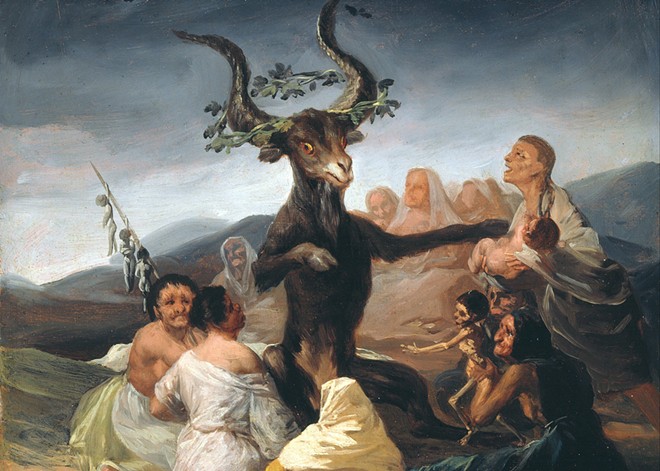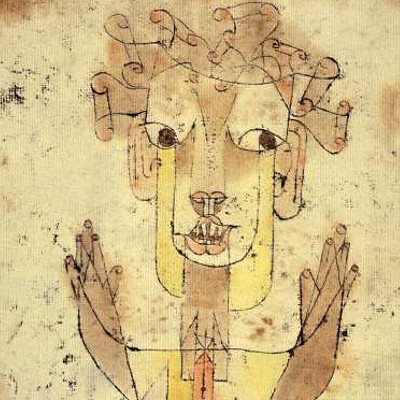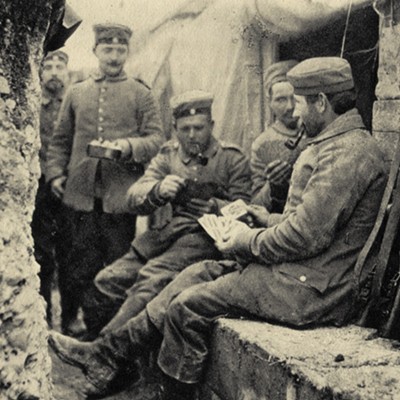King James I had a morbid fear of violent death. His mother, Mary Queen of Scots, was beheaded by Elizabeth I. In 1605, there was an assassination attempt using a Brobdingnagian cache of gunpowder. Then there were the witches. Sailing with his 13-year-old bride from her native Denmark, his ship was nearly wrecked by raging seas. James blamed witches, who he believed had conjured the storm.
James was author of the King James Bible, and his Daemonologie (1603) was the manual of the 17th century Protestant witch persecutions. (See the 1922 Swedish-Danish film Häxan.) James was openly gay. In a grim irony, as inquisitors were battling the witch scourge armed with James' manual, when bundles of kindling were exhausted in the burning of witches, gay people were used to fuel the flames.
Seventeenth century Europe was rife with destruction and despair: Religious schism, devastating war, climate change, famine and plagues. It seemed that God had abandoned humanity, with evil remaining to haunt the forsaken. This terrifying milieu produced the most savage witch persecutions in European history.
It hadn't always been that way. Earlier witches were venerated as practitioners of "white magic" — healers and guardians of the field and flock. Out of that tradition came the good witch Strega Nona and the 1815 Grimm tale it was based upon.
With the Protestant Reformation, the Catholic Inquisition fanatically prosecuted any deviation from orthodoxy — even Martin Luther admonished his Protestant brethren "to not suffer a witch to live." Now the witch was a malevolent, nocturnal spectral riding a broom accompanied by demons to Satanic orgiastic rituals and feasting on children's flesh. (See Francisco Goya's witch paintings of 1797-98.) Shakespeare's witches in Macbeth (1623) concoct a brew of "eye of newt, toe of frog" to arouse dead souls.
Consider the evil witches in Grimm's Hansel and Gretel or in Russian folklore's Baba Yaga. There is credible evidence that parents engaged in infanticide and filicide attributing these acts to witches or Jews in the latter's fictive "blood libels." This "evidence" justified some witch persecutions and pogroms. The most bizarre evidence to convict a witch was the discovery of a "witches' teat," an extra nipple allegedly used to suckle the witch's animal imps.
Eighty percent of witches persecuted in the 17th century hysteria were women. Even the word hysteria is derived from the Latin root for uterus. Freud believed hysteria to be exclusively a female malady. The feminization of madness, the conviction that women were psychologically and intellectually weak and thus prostrate to the temptations of the flesh and prone to sin, were pernicious patriarchal constructs.
The Malleus Maleficarum (The Witch's Hammer, 1486) ordained "that witchcraft comes from carnal lust, which is in women insatiable." Milton affirmed women's subservience to man in Paradise Lost: "He for God, she for God in him."
The women who were persecuted as witches were usually single or widowed, of lower economic status, and did not conform to the societal strictures expected of women. Alleged witches' confessions were extracted through torture or the "swimming test." Torture included thumbs screws, bone crushing leg vices, and the strappado. In the swimming test, the accused was bound and submerged in water. If she survived, she was judged a witch and burned; if she drowned she was innocent. In 17th century Europe, an estimated 50,000 to 80,000 witches were executed.
The witch carnage in Europe dwarfs the 1692 Salem hysteria with 20 persons executed. (See Stacy Schiff's The Witches.) Several variables converged on late 17th century Salem to intensify paranoia: A succession of cold winters and crop failures, the "papist" French assailing pious Protestant communities in neighboring New York, and the colony being besieged by violent Indian attacks, the latter which "obliterated a third of New England's towns, pulverized its economy, and claimed 10% of the male population," Schiff wrote.
Puritan minister Cotton Mather sermonized in 1691 that the Apocalypse was imminent. Surely Satan's handmaidens were afoot. The Salem accusers were 10 girls ages 11-19. The rigid restraints imposed on Puritan adolescent girls and the Puritan doctrine of the irredeemable sinfulness of the individual with women most predisposed to guilt rendered these accusers prostrate to Puritan patriarchal control and suggestion. These repressed adolescent girls, guilted further by the "unclean" outset of menses, discovered power and authority through incriminating elders as witches.
In the trials of the accused, the girls' histrionics were compelling. When the alleged witch attempted to defend herself, the girls were consumed with "fits" accompanied by seizures, violent contortions and bloodcurdling screams, as if possessed by the accused. Some of the afflicted girls claimed that they saw a "black man" speaking in the ear of the defendant, a then-common reference denoting an indigenous person.
Even at the time, there was evidence that the afflicted girls had perjured the accused. Years later, one of the girls recanted her accusations insisting she was coerced by a minister. In 1697, the judge and the Salem jury apologized. None of these accusers was tried, punished or publicly reprimanded. The witch fever abated, but the disease was only in remission. The contagion surged again in the 19th century in anti-Catholicism and the first Red Scare initiated by the 1886 Haymarket executions. In the 20th century, the 1919-20 Red Scare and the McCarthyism of the 1950s are proof again.
The malady of misogyny that gestated the evil progeny of witch hysteria persists. Like the Puritans, today the "godly" brandish biblical verse to scourge women who transgress patriarchy. The persecuted in this latest crucible include the daughters of Sinead, the sisters of AOC, and women who defy those unknowable cider house rules by consorting with an angel of deliverance and refusing to wear the court's letter "A."
They are the women who shattered a glass ceiling, not femme fatales of Mad Men locker room derision like Lydia Tár or Elizabeth Holmes, but who played the game fair and square on an uneven field. And they are the Barbies who prefer Kim to Ken.
Alas, perhaps it is instructive that the Salem persecutors may have had this belated epiphany from the King James Bible: "Judge ye not or ye too will be judged." ♦
John Hagney taught high school and college history for 45 years. He was a U.S. Presidential Scholar Distinguished Teacher. His oral history of Gorbachev's reforms was the first work on the subject and has been translated into six languages.



















